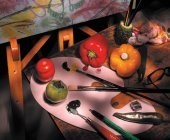|
DSLR CameraDSLR - digital single lens reflex camera has a similar design of an analog SLR camera, but there is a slight difference. This difference does not affect the operation of digital SLR camera, and we will not even notice it.
The basic requirement to see precisely what we are going to record on the film, led to the development of the single lens reflex camera design. This is the design, adopted by many manufacturers for its unmatched features. The same basic mechanism is used in a digital version of an SLR. A mirror is placed at 45 degree between the lens and the digital image sensor, which is similar to an analog SLR design. This mirror reflects the preview of an image to the eyepiece. At this time, the aperture of the lens remains wide open for a bright view, just like an analog version.
This whole sequence is done in fraction of a second. And that is the reason why the camera is complicated in design, bulky, noisy and expensive. Advantages and drawbacks of these cameras are exactly same as its analog counter part.
Digital SLR cameras use either full frame image sensor, which is 36 x 24 mm or a smaller image sensor, which is about 24 x 15 mm. (size of the sensor depends on model of a camera) Full frame image sensors are expensive, but they give much more better picture quality. Digitized noise artifact is less compared to the smaller image sensor. However, many cameras are having a small size sensor, which makes them cheaper. High end medium format digital SLR and EVIL cameras use image sensor, which is approximately 50 mm x 40 mm in size. (Actual size depends on model and make).
When a digital image sensor is smaller, it is like having a smaller film in the camera. When size of a film (or image sensor) is small, the lens will not cover the angle of view as it will cover with a full frame film or image sensor. So in this case, a wide angle lens of 18 mm focal length will cover the angular view, which is equivalent to 28 mm lens on full frame image sensor. The same maths is applied to all other lenses and a 50 mm normal lens of a full frame camera will give result of around 75 mm on small frame. We can use lenses of full frame camera on small frame camera, as these lenses produce larger image circle and can cover the small frame. However, a lens designed for a small frame camera cannot be used on a full frame camera as the circle of image produced by these lenses is much smaller. Image will not reach till corners of the full frame digital image sensor, resulting vignette on corners. DSLR is commonly referred to cameras, that appear like a 35 mm analog SLR cameras, however, technically, any camera with reflex mirror mechanism is an SLR, and digitized version, irrespective of image sensor size, is to be categorized as a DSLR - digital single lens reflex camera.
Return back to Home Page from DSLR
|






